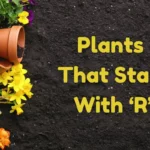List of practical gardening tools with illustrations. It will be extremely helpful for you if you can talk about gardening tools and use their English names if you enjoy spending a lot of time in the garden. If you work in gardening, such as a landscaper or florist, this vocabulary will also be very helpful to you.
Gardening Tools – List of 25+ Useful Tools Names for Gardening With Picture

However, knowing the names of gardening tools will not only improve your ability to communicate on the subject but will also improve your comprehension of spoken English. You can expand your vocabulary by learning the names of several gardening tools in English in this section.
A gardening tool, also known as a garden tool, is any of the numerous tools made for gardens and gardening, which also includes a variety of tools made for agriculture and horticulture. Both hand tools and power tools can be used as garden tools.
With the aid of these tools, gardening tasks like digging, planting, transplanting, clearing the garden of trash and dry leaves, and watering the plants can be carried out quickly and easily. The goal of gardening tools is to perform quick and efficient tasks in the garden; having a large collection or buying every tool is not required. In this article, we will learn about Gardening Tool Name in English with pictures.
Watering Can
The watering can is a small, lightweight water container made of tin or plastic fiber with a handle for holding in the hand while watering small plants. The watering can’s mouth is shaped like a funnel, a short pipe, and a showerhead so that it spreads out over the plants like rain.
Garden Hose
A garden hose is a flexible watering pipeline that is used to water plants in gardens. Additional attachments, such as a tap, pressure nozzles, or sprinklers that scatter water throughout the garden, are also available. When watering a large area in the garden from a single location, it is used.
Gardening Gloves
Like regular gloves, gardening gloves are made of polymer and rubber to protect wearers from the chemicals, fertilizers, and pesticides present in garden soil. While working in the dirt and water of a garden, also keeps our fingers and nails clean.
Shovel
When it’s necessary to prepare the soil for plant planting, a long shovel is used in gardening. The loose soil around plants or in other areas of the garden is also removed using this method. It goes by several names, including a garden shovel, garden trowel, hand shovel, and occasionally garden spades.
Garden Trowel
A garden trowel is a small-scale digging tool with a pointed scoop shape that resembles a spade or a shovel. With the help of this trowel, we can easily grow plants and improve their nutrition by clearing the soil of weeds, extra grass, and unwanted waste. To help the plant grow better or move it from one pot to another, we can also use it to loosen the soil around the roots.
Sickle
One of the earliest gardening implements is the sickle, which is used to harvest a variety of crops and plants, including rice, wheat, grass, and other scrubby underbrush, vegetables, and cereal plants. It has a wooden handle head and a metallic, curved portion with a sharp edge that cuts through weeds, grass, and other plants with ease, but cutting and handling practice are necessary. Although it cuts the fingers easily and hurts you, it is also extremely dangerous for beginners. It is one of the most helpful gardening tools and is used for more than just pulling weeds.
Fertilizer
The nutrients, phosphorus and other necessary elements that help crops grow more quickly and productively are supplied to them by fertilizers, which are chemical or organic compounds.
Rake
The rake is a broom designed for outdoor use because it has a handle on one end and a toothed bar on the other. It is used to gather dry leaves, hay, and grasses in one area. In the garden, we can also use it to level loose materials like soil, mulch, or leaves.
Lawn Mower
It is a mechanical device used to trim the excessively growing garden grass and level it out in the garden. It can remove ground-grown weeds and grass that has grown extensively.
Flowerpot
The flowerpot is a jar-like structure used for planting seeds or small plants after filling it with soil. The benefit of growing a plant in a pot is that we can move it around at any time to different locations.
Apron
An apron is a piece of cloth that covers the front of the body, running from just below the knees to about mid-chest. It is typically worn over clothing and frequently shields that person’s clothing from spills or stains.
Bucket
Buckets are typically made of metal or plastic and have a sizable opening at the top. Buckets have a wide range of applications. They can transport both dry goods and other liquids in addition to water, which is their usual use. Some buckets have seals, while others don’t.
Gardening Fork
A tool with a long handle and two or more tines is known as a gardening fork. The tines are used to move compost, mulch, and other materials as well as to loosen the soil and pull weeds out of the ground. The soil is turned and aerated with the aid of a gardening fork.
Hedge Shears
Hedge and shrub trimming is done with hedge shears. They possess a blade with a cutting edge on one side. A hedge shear is a cutting device with a long blade and a scissor-like motion. Hedge and other shrub trimming are done with it.
Pruning Saw
In gardening, landscaping, and arboriculture, a pruning saw is a particular kind of saw. A pruning saw’s long, curved blade has a cutting edge. It is therefore perfect for cutting through woody or branchy material.
Shed
A shed is a very small structure used for storage or as an outdoor workshop. These structures are typically found at the back of the house and are frequently used to store bicycles, lawnmowers, and gardening equipment.
Scythe
A straightforward tool for harvesting grain is the scythe. Despite being centuries old, it is still in use today. It is simple to use and facilitates harvesting.
Wheelbarrow
A cart with two sizable wheels that can be pushed or pulled is called a wheelbarrow. The original purpose of wheelbarrows was for workers to transport materials around a job site.
Wheelie Bin
Large plastic or metal containers called “wheelie bins” are used to collect and discard waste, recycling, and other household items. They can be made of steel or plastic, with plastic typically being less expensive.
Spade
For planting and transplanting, spades are ideal. For removing plants from the ground or digging holes, the flathead design is perfect. It’s crucial to remember that a garden spade works best in loose soil that isn’t rocky or compacted.
Axe
The term “grub axe” refers to the method of using the tool, which is excellent for grubbing in rocky terrain and compacted soil. These implements are very helpful in the garden because they can break up stubborn roots of older plants or dig holes to plant new plants.
Plant Pot
Typically, a pot that better accommodates a plant’s root system is used. Repotting is typically done by the size of the plant’s root system. The majority of plants require repotting every few years because their roots or “pot-bound.”
Seeds
Both biologically and economically, seeds are significant. They are rich in protein, starch, and oil, which are vital nutrients for the growth of both plants and people. They contribute to the production of numerous primary human food sources.
Fence
A fence is an effective way to separate your garden from the rest of your backyard and keep animals out. However, garden fences can make your flower bed or vegetable garden look nicer. Mesh, a semi-permeable barrier made of metal fibers, is the unit of measurement for fencing and can vary depending on the type of fence being measured.
Flower Bed
The flowerbeds in a garden are arguably its most attractive feature. Herbaceous In flower beds, annuals with seasonal blooms are cultivated. Annuals are a spectacular source of color in the garden because they look natural and thrive in open spaces.
Ladder
They are lightweight, adaptable, and useful for a range of tasks. While they can facilitate a variety of tasks, they also pose a risk to personal safety. You can take precautions to avoid ladder-related injuries for both you and other people.
Boots
Whether you are a seasoned gardener or have only recently begun tending to your petunia patch, it’s crucial to feel secure and at ease. While weeding and watering your plants, gardening boots help keep your feet dry. They can also act as an additional layer of insulation against the cold.









